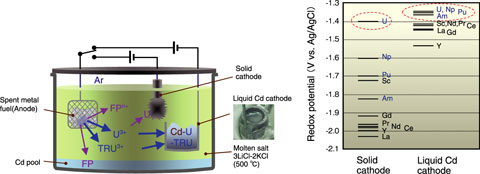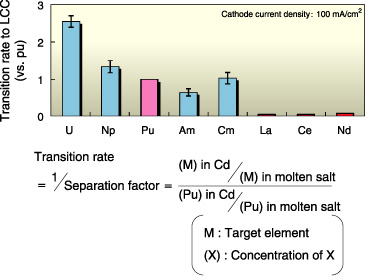
Fig.1-25 Concept of the electro-refining process and standard redox potential of TRU and rare earth elements

Fig.1-26 Result of the TRU recovery experiment with liquid cadmium cathode
Pyrochemical reprocessing technology (metal electro-refining method) has been developed as a candidate future reprocessing technology. In this process, U and Pu are separated from fission products (FP) and recovered by electrolysis. Fig.1-25 shows the concept of electrolysis at the electro-refining step and the principle of element separation. The deposition potential to a cathode depends on the material of the cathode as well as the element. A molten chloride mixture (LiCl and KCl in this method) is used to lower the electrolyte melting point.
The spent metal fuel pins are chopped into segments and loaded into a steel basket, then the basket is placed in the molten salt as an anode. Moreover, the cathodes consist of two kinds of electrodes: a solid cathode made of iron, and liquid cadmium filled in a ceramic crucible. Uranium, TRU, and some kinds of FP are anodically dissolved into molten salt and deposited on the cathodes by electrolysis. As shown in the right-hand diagram in Fig.1-25, U metal is selectively recovered on the solid cathode by controlling cathode potential. Subsequently, U and TRU are recovered into the LCC by electrolysis as they are dissolved from the anode. The selective recovery of a specific actinide is difficult because their deposition potentials to the LCC are close to each other. FP elements such as rare earth elements (REE) can be separated from actinides due to differences in their deposition potential to the LCC from those of actinides. Thus, the simultaneous recovery of U and TRU is suited to a future nuclear fuel cycle concept that aims to recycle all actinides. The difficulty of separating pure Pu is a desirable feature from the nuclear non-proliferation perspective.
Fig.1-26 shows results indicating that the LCC has these kinds of thermodynamic features. Actinide elements could be recovered simultaneously with the LCC and separated from REE (La, Ce and Nd) by electrolysis, as was expected from the thermodynamic study. We are planning to obtain further experimental data for the development of a superior electrolysis technique.